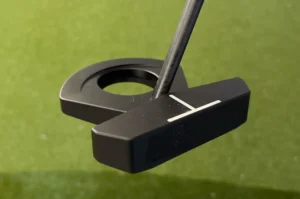Faced with a downhill chip shot, many amateur golfers struggle to make solid contact and control distance. The slope changes how the club interacts with the ball, often leading to thin shots or chunks. Fortunately, with some adjustments to stance, weight shift, and club selection, you can conquer downhill chips.
Follow these 7 keys to mastering downhill chip shots:
How to Chip from a Downhill Lie
1. Assess the Severity of the Downslope
Before stepping up to hit any downhill chip, take time to evaluate the slope. Gauge how steep it is and how that will impact your shot. Also consider the contours of the green. A severe side-hill lie requires more adjustment than a slight downslope. And if the green runs away from you, the chip must travel farther.
Determining slope severity and green contours allows you to visualize the proper shot shape, trajectory, and required carry distance. You can then dial in your setup and technique.
2. Widen Your Stance for Increased Stability
One of the most important downhill chipping adjustments is widening your stance. A wider base of support provides critical balance on the angled slope. Most golfers should widen their stance 4 to 8 inches compared to flat-ground chip shots.
Aim to have your feet slightly wider than shoulder width apart. Flex your knees with weight centered between your feet. Avoid an overly wide stance that reduces body rotation. Find the optimal width through practice swings and experience.
3. Tip Your Shoulders Parallel to the Slope
As you widen your stance, also be sure to tip your shoulders parallel to the downslope. This prevents swaying and inadvertent hand action caused by the angle.
By matching your upper body alignment to the slope, you maintain spine angle consistency. With shoulders tipped downslope, you can freely hinge your wrists and rotate your body. The sloped shoulders eliminate manipulation of the clubface through impact.
4. Shift Weight Onto Your Front Foot
Along with a wide base and tilted shoulders, proper weight distribution is vital for downhill chips. Your weight should be biased toward the front foot, lowered on the slope.
Ideally, distribute around 75% of your weight to the front foot and 25% to the back foot. This places your body mass over the ball for solid contact. Avoid leaning too far back, which reduces effective loft and often results in thin shots.
5. Choose a Lob Wedge for Maximum Loft
The downhill slope reduces your effective loft, so opt for the most lofted wedge in your bag. For most golfers, this will be a 60-degree lob wedge. The extra loft adds lift and prevents thin shots.
Also consider bounce. Wedges with more bounce can be helpful for downhill lies in certain turf conditions. Grind is also a factor when the lie is sloped or tight. Consult your local pro on optimizing wedge selection.
6. Strike the Ball First With a Descending Blow
Though you shift weight forward, the ball position remains in the center of your stance for downhill chips. This allows you to make ball-first contact with a slightly descending blow.
Let the loft of the wedge work for you – resist scooping or adding loft. Swing through impact on a shallow path. The grooves will impart overspin to get the ball in the air and landing soft.
Modify the descending blow as needed based on slope severity, lie specifics, and distance demands. Steep short-sided downhill chips often require more of a level-out approach.
7. Practice Chipping Drills to Hone Technique
Grooving a repeatable downhill chipping motion requires practice and drills. Here are some excellent ways to ingrain proper setup and technique:
- Hit chips with feet together, then add width to feel stability benefits
- Align shoulders to match slopes of varying degrees
- Check weight distribution consistency with backfoot brush drill
- Drop pool noodles or alignment rods to rehearse required trajectories
- Hit chip shots to closely mowed “greens” to develop distance control
8. Execute Your Chipping Swing Confidently
Once you have the adjustments down and have practiced enough, it’s time to trust your technique. Step up the downhill chip with commitment and make a confident swing focused on your target.
Maintain tempo through the motion to ensure solid contact. Hold your finish and watch the ball onto the green. Avoid decelerating or flinching from the sloped lie.
Final Verdict: Proper Setup and Technique Are Key
Downhill chip shots can be intimidating. But adhering to key adjustments for stance, posture, weight shift, club selection, and angle of attack allows you to conquer the challenge. Address the slope, commit to your shots, and execute consistently. You will begin saving crucial strokes with quality downhill chips.
Mastering these 7 tips – from assessing the slope to confidently swinging – is the formula for success. Dial in proper setup and technique for your downhill chips. Soon you will attack sloped lies with precision and consistency to meet scoring goals.
Practice chipping drills to get better at tackling downhill chip shots








